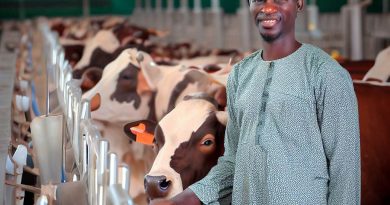Emerging Trends and Technologies in Agricultural Operations Management
Last Updated on August 15, 2023
Introduction
In order to thrive in the future of agricultural operations management, it is crucial to embrace and adapt to the emerging trends and technologies.
Emerging trends and technologies in the agricultural industry are the latest advancements that revolutionize farming processes.
These innovations aim to streamline operations, increase yields, minimize waste, and reduce environmental impact.
One of the emerging trends is precision agriculture, which utilizes satellite imagery, GPS technology, and drones to gather data about soil conditions, crop health, and water usage.
This data is then analyzed to provide farmers with valuable insights that can optimize their decision-making processes.
Another significant trend is vertical farming, a technique that involves growing crops in stacked layers, using controlled environments such as artificial lighting and hydroponic systems.
Vertical farms allow for year-round production, higher yields, and the ability to grow crops in urban areas, reducing transport costs and carbon emissions.
Furthermore, the use of robotics and automation in agricultural operations management is revolutionizing farming practices.
Robots can perform tasks such as planting, harvesting, and monitoring crops, reducing the need for manual labor and increasing efficiency.
This blog post will delve further into these emerging trends and technologies in agricultural operations management, exploring their benefits, challenges, and potential future developments.
By adopting these advancements, farmers can improve productivity, sustainability, and profitability in an ever-evolving industry.
Stay tuned for our next chapters, where we will extensively discuss each trend in detail.
Precision farming
Definition and explanation of precision farming
Precision farming refers to the use of advanced technologies and techniques to optimize agricultural operations.
It involves collecting and analyzing data to make informed decisions and maximize productivity.
Precision farming plays a crucial role in modern agricultural operations management, bringing numerous benefits and advancements.
By using precise data and sophisticated technology, farmers can make informed decisions to optimize resource usage, increase productivity, and maintain environmental sustainability.
Benefits and advantages
- Improved resource efficiency: Precision farming allows farmers to precisely apply resources like water, fertilizers, and pesticides, reducing waste and cost.
- Increased crop productivity: With precision farming, farmers can monitor and adjust various factors, such as irrigation and nutrient levels, to optimize crop growth and yield.
- Sustainability and environmental conservation: By minimizing the use of chemicals and reducing resource waste, precision farming promotes sustainable agricultural practices and helps protect the environment.
One of the primary advantages of precision farming is improved resource efficiency.
Through precise application techniques, farmers can minimize the use of resources like water, fertilizers, and pesticides.
By analyzing data from various sensors, such as soil moisture and nutrient sensors, farmers can determine the exact requirements of their crops.
This targeted application reduces waste and costs while ensuring that crops receive the necessary resources for optimal growth.
Increased crop productivity is another key benefit of precision farming. By monitoring and adjusting various factors, such as irrigation, nutrient levels, and plant density, farmers can optimize crop growth and maximize yields.
Real-time monitoring systems provide accurate data about crop health, allowing farmers to identify and respond to issues promptly.
With the ability to make data-driven decisions, farmers can ensure that crops receive the ideal conditions for growth, resulting in higher productivity and profitability.
Precision farming also promotes sustainability and environmental conservation. By minimizing the use of chemicals and optimizing resource application, precision agriculture reduces environmental impact.
By using technologies like GPS and remote sensing, farmers can precisely apply fertilizers and pesticides only where needed, reducing the risk of environmental contamination.
Additionally, the ability to monitor soil health, moisture levels, and weather conditions helps farmers plan irrigation schedules effectively, minimizing water wastage.
Examples of precision farming technologies
- GPS and remote sensing: Global Positioning System (GPS) technology enables farmers to precisely locate and track their equipment, while remote sensing helps gather data about crop health and soil conditions.
- Drones and aerial imaging: Drones equipped with cameras or sensors provide farmers with detailed imagery of their fields, aiding in crop monitoring, pest detection, and mapping.
- Automated machinery and robotics: Precision agriculture relies on automated machinery and robotics, such as self-driving tractors or robotic harvesters, to perform tasks more efficiently and accurately.
Several examples of precision farming technologies demonstrate its practical implementation.
GPS and remote sensing allow farmers to precisely track and locate their equipment, optimizing field operations.
Remote sensing technologies, including satellites and drones, provide farmers with detailed imagery, enabling them to monitor crop health, assess vegetation stress, and detect pests or diseases.
This information helps farmers make informed decisions regarding crop treatment, leading to improved overall crop performance.
Drones and aerial imaging offer a more detailed perspective of the fields, allowing farmers to identify and address specific issues accurately.
They can create detailed maps of their fields, providing insights into soil variations, crop growth patterns, and areas prone to diseases or pests.
With this information, farmers can apply targeted treatments, improving crop health and ensuring efficiency in resource utilization.
Self-driving tractors equipped with GPS technology can perform tasks with incredible accuracy, reducing human error and optimizing field operations.
Robotic harvesters enable faster and more precise harvesting, minimizing crop damage and labor requirements.
Precision farming is transforming agricultural operations management through the integration of advanced technologies.
By employing precision farming technologies like GPS, remote sensing, drones, and automation, farmers can make informed decisions and optimize their operations for better overall outcomes.
Read: Skills Needed for Agronomy Sales Management in Nigeria
Data-driven decision making
Agricultural operations management is evolving rapidly as emerging trends and technologies revolutionize the industry.
One major aspect that is driving this transformation is the use of data-driven decision making.
Importance of data in agriculture
Data plays a critical role in the agriculture sector by providing valuable insights and enhancing decision-making processes.
It allows farmers and agricultural businesses to make informed choices based on real-time information and analysis.
Role of data analytics in making informed decisions
Data analytics has emerged as a powerful tool in agricultural operations management, enabling farmers to optimize their operations and improve productivity.
By leveraging advanced analytics techniques, farmers can extract meaningful patterns and trends from vast amounts of data.
Examples of data-driven decision making in agricultural operations management
Data-driven decision making can be applied to various aspects of agricultural operations management, including:
Yield monitoring and prediction
Through the use of sensors and precision agriculture technologies, farmers can collect data on crop health, soil moisture, and weather conditions.
This data can then be analyzed to predict crop yields, allowing farmers to optimize their planting and harvesting schedules and make informed decisions about resource allocation.
Disease and pest detection
Data analytics can help identify patterns and early indications of diseases and pest infestations in crops.
By analyzing data collected from sensors and imaging technologies, farmers can detect potential threats and implement preventive measures to protect their crops, minimizing losses and ensuring sustainable production.
Supply chain optimization
Data-driven decision making also plays a crucial role in optimizing the agricultural supply chain.
By analyzing data on demand, transportation logistics, and inventory levels, farmers can make data-informed decisions regarding storage, transportation routes, and distribution strategies.
This ensures efficient supply chain management, reducing costs and minimizing waste.
In fact, data-driven decision making is transforming agricultural operations management.
By harnessing the power of data and analytics, farmers can make informed choices, optimize their operations, and enhance productivity.
The examples mentioned above demonstrate the potential applications of data-driven decision making in improving yield prediction, disease detection, pest control, and supply chain optimization.
As technology continues to advance and data becomes more accessible, the importance of data-driven decision making will only continue to grow in the agriculture industry.
Read: Training and Education for Agronomy Sales Managers

Use of Artificial Intelligence and Machine Learning
Overview of Artificial Intelligence and Machine Learning in Agriculture
Artificial intelligence and machine learning are revolutionizing agricultural operations management.
Advantages and Potential Applications
- Crop and livestock monitoring and management: AI and machine learning algorithms can analyze data from sensors and drones to monitor plant health and animal behavior.
- Predictive analytics for weather and market trends: By analyzing historical data, AI can provide accurate predictions for weather patterns and market demand, helping farmers make informed decisions.
- Smart irrigation and water management: Using AI technology, farmers can optimize water usage by automatically adjusting irrigation systems based on weather forecasts and crop needs.
Case Studies Showcasing the Use of AI and Machine Learning in Agricultural Operations Management
Case Study 1: Crop Yield Optimization
In a study conducted by a leading agricultural research institute, machine learning models were used to analyze soil properties, weather data, and crop characteristics to optimize crop yields.
The models suggested optimal planting patterns, fertilizer application rates, and irrigation schedules, resulting in significantly increased yields.
Case Study 2: Livestock Health Management
A dairy farm implemented an AI-based system that monitored key parameters such as milk production, feeding patterns, and body temperature of individual cows.
Machine learning algorithms analyzed this data to detect early signs of diseases or abnormalities, allowing timely intervention and reducing veterinary costs.
Case Study 3: Market Demand Prediction
A group of vegetable growers used AI-powered predictive analytics to forecast market demand for different produce.
By analyzing historical sales data, weather conditions, and social media trends, they were able to optimize their planting decisions, prevent overproduction, and meet consumer demands effectively.
Case Study 4: Weed Detection and Management
An organic farm integrated AI and machine learning technology into their weed management strategy.
By analyzing images captured by aerial drones, the system accurately identified weeds and distinguished them from crops.
This enabled precise application of herbicides, reducing chemical usage and minimizing crop damage.
Case Study 5: Disease Diagnosis
A plant pathology laboratory developed an AI system capable of diagnosing plant diseases based on images of symptoms.
By comparing the visual patterns with a vast database of known diseases, the system could accurately identify the cause of the problem and suggest appropriate remedies, saving time and preventing yield loss.
In the end, the use of artificial intelligence and machine learning in agricultural operations management brings numerous advantages and potential applications.
From crop and livestock monitoring to predictive analytics and smart irrigation, these technologies are transforming the way farmers make decisions and optimize their operations.
The showcased case studies illustrate how AI and machine learning have already proven effective in various areas of agriculture, promising a more efficient and sustainable future for the industry.
Read: Importance of Agricultural Operations Managers in Nigerian Agribusiness
Sustainable practices and technologies
Growing demand for sustainable agricultural practices
The increasing awareness of environmental issues has led to a surge in demand for sustainable agricultural practices. Consumers are becoming more conscious of the need to support practices that minimize harm to the environment.
Technologies and trends promoting sustainability
To meet the demand for sustainable practices, several emerging technologies and trends have surfaced in agricultural operations management.
Organic farming practices
Organic farming is a sustainable practice that avoids the use of synthetic fertilizers, pesticides, and genetically modified organisms (GMOs).
Conservation tillage and precision irrigation
Conservation tillage techniques minimize soil erosion and preserve soil structure, while precision irrigation ensures optimal water usage by delivering water directly to the plant roots.
Renewable energy systems in farming operations
The adoption of renewable energy systems, such as solar panels and wind turbines, is gaining popularity in farming operations. These systems provide clean and sustainable energy sources.
Benefits and potential challenges of adopting sustainable practices
The adoption of sustainable practices in agricultural operations management offers several benefits but also comes with potential challenges.
Some of the benefits include:
- Improved soil health and fertility
- Reduced reliance on chemical input
- Enhanced biodiversity and ecosystem preservation
- Increased consumer trust and market demand
However, there are also challenges associated with adopting sustainable practices:
- Transition costs and initial investment
- Technical knowledge and skills required for implementation
- Potential yield variability during the transition period
- Availability and accessibility of sustainable inputs
Despite these challenges, the benefits of adopting sustainable practices far outweigh the potential drawbacks.
The long-term environmental sustainability and profitability of agricultural operations depend on the adoption of these practices.
The growing demand for sustainable agricultural practices has spurred the development and adoption of various technologies and trends.
From organic farming to conservation tillage and renewable energy systems, these practices promote environmental preservation and long-term profitability.
Although there are challenges involved, such as initial investment and technical knowledge requirements, the benefits of adopting sustainable practices make it a worthwhile venture for agricultural operations management.
Read: Emerging Trends in Agronomy Sales in Nigeria
Future Prospects and Challenges
Exploration of Future Trends and Technologies in Agricultural Operations Management
- Blockchain technology for supply chain transparency.
- Internet of Things (IoT) in farming.
- Vertical farming and urban agriculture.
Challenges and Obstacles to Adopting Emerging Trends and Technologies
- Cost and accessibility.
- Skills and knowledge gaps.
- Resistance to change.
Highlighting the Importance of Staying Updated on Emerging Trends and Technologies in Agricultural Operations Management
In order to thrive in the future of agricultural operations management, it is crucial to embrace and adapt to the emerging trends and technologies.
Blockchain technology can enhance supply chain transparency, allowing consumers to have confidence in the origin and quality of their food.
The Internet of Things (IoT) enables farmers to gather real-time data on crop conditions and improve their decision-making processes.
Vertical farming and urban agriculture offer more sustainable and efficient methods of food production, reducing the environmental impact.
However, several challenges need to be addressed to fully adopt these technologies. The cost and accessibility of implementing such systems can be a barrier, especially for small-scale farmers.
Moreover, there is a need for acquiring the necessary skills and knowledge to effectively utilize these technologies.
Lastly, resistance to change within the agricultural community can hinder the widespread adoption of these emerging trends and technologies.
It is crucial for farmers and agricultural professionals to stay updated on these advancements and be open to embracing change.
By staying ahead of the curve, they can gain a competitive edge, improve productivity, and contribute to a more sustainable and efficient agricultural industry.


